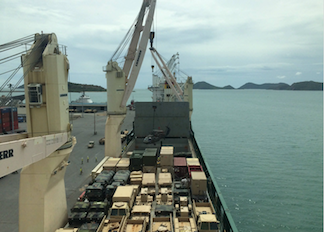The following is text of a news report from the U.S. Naval Institute (USNI):
(NATIONAL HARBOR, Md.) — The few American-built and operated tankers available to carry fuel for aircraft, tanks, fighting vehicles and trucks into war zones throws into sharp relief the strategic sealift problems facing the nation, a senior Maritime Administration (MarAd) official told USNI News.
There are six vessels currently available to meet the wartime need of shipping fuel and petroleum products to support American forces, said Kevin Tokarski, MarAd's associate administrator for strategic sealift. Referring to the tankers, “it’s the only area we don’t have assured” in wartime. Following Hurricane Irma, waivers were required to use foreign vessels to transport fuel to Puerto Rico.
“While there’s recognition of current shortfalls,” there is a need to press ahead buying and building more tankers, he said. “This is an area we seriously need to address.”
There are two ways to proceed in the case of the tankers: reflagging existing vessels, or funding new construction to increase the number of ships available.
“Reflagging used vessels would be the quickest,” a line that can be pursued with existing congressional approval to replace a host of vessels, Tokarski said following a panel on strategic sealift at the 2019 Sea-Air-Space symposium.
The real challenge in Tokarski’s eyes is finding cargo for these vessels to move when not deployed for government service. It’s a challenge, he said, because the United States does not export a great deal of its domestically produced petroleum, nor does it use oceangoing vessels to transport fuel around the nation. He also said builders and carriers would need incentives.
The government should consider partnering with industry to fund construction of new vessels, with the understanding these vessels would be available for government use during times of crisis, he said.
Private shippers usually keep a vessel for 10 to 13 years and then sell it, Tokarski said. The purchaser could be the government. “I can get 30 years of service out it,” he said. The cost-sharing could break down to 25 percent for the private sector and 75 percent for the government. Tankers, he said, “have about a 40-year life span.”
The “cargo challenge” exists for other types of vessels in the nation’s Jones Act fleet, and as a result, there are few jobs for American merchant mariners because there are fewer and fewer vessels to operate. During the panel discussion, Tokarski said only 78 U.S.-flagged vessels are engaged in international trade, and the shortfall of 1,400 to 1,800 experienced mariners required to sustain an overseas military operation will only grow as the fleets operated by MarAd, under the Department of Transportation, and by the Military Sealift Command continue aging into obsolescence.
Using Navy figures on the 130 vessels in its portfolio, prepositioned ships average 24 years old, surge capacity ships 30 years, and the Ready Reserve Fleet averages 40 years.
The age, the cost of maintenance and the continuing drop in readiness in the sealift fleet “is a trend that should capture your attention,” said Christopher Thayer, MSC’s director of strategic mobility and logistics.
The other side of the readiness equation is having qualified American crews.
“It takes 10 to 13 years to gain the experience necessary” to command large merchant vessels, said T. Christian Spain, vice president of government relations for the American Maritime Officers. But like the military services, “at the 10-year mark, we run into a problem, the problem of retention.”
“Each one of these ships have two crews,” like the Navy’s submarines, he said. After the initial six-month push for an operation, “you’re going to need replacements.” That’s where the manpower shortage becomes most noticeable.
Spain and others also predicted that six more American vessels are about to go out of coastal or international trade. When those vessels are no longer operating, 250 more trained and experienced American mariners will be out of work.

